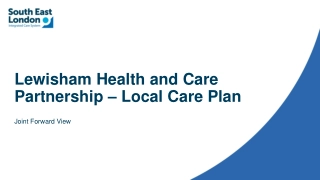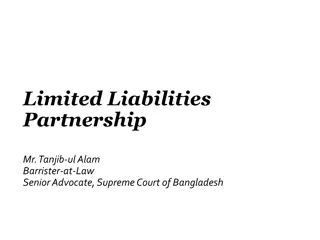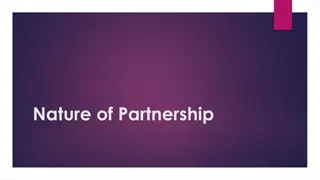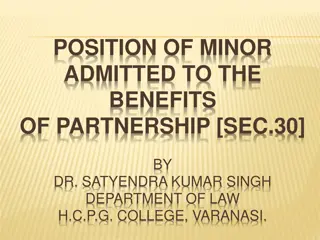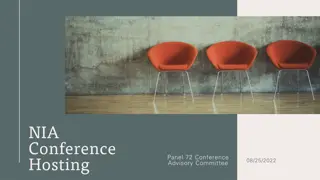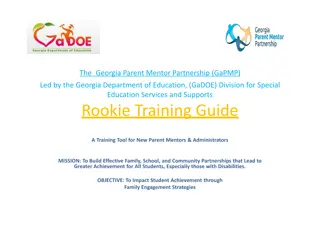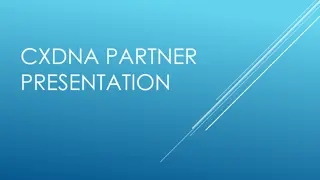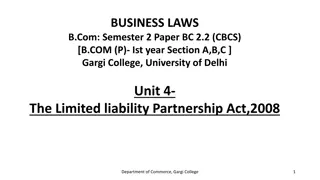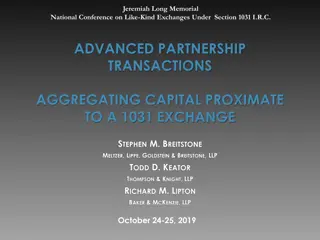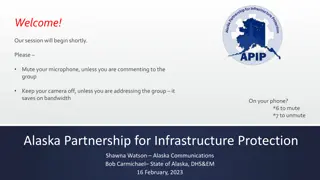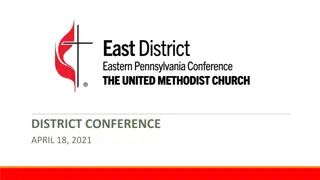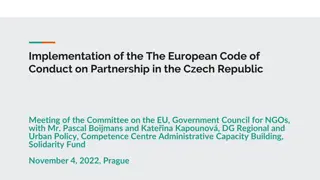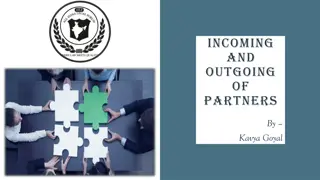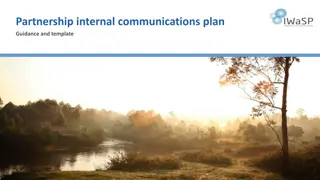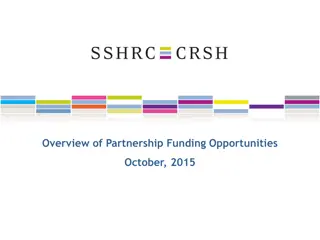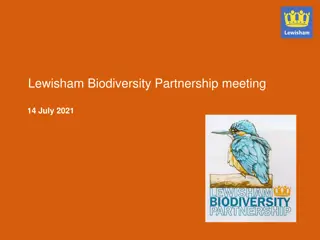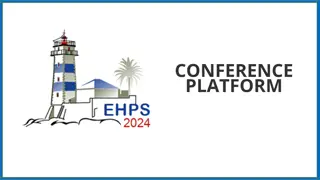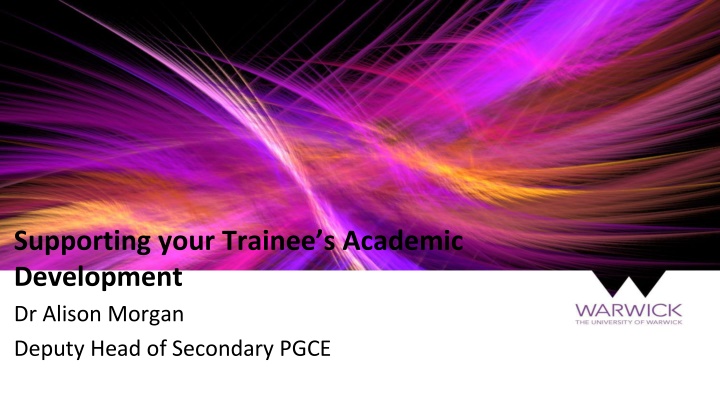
Supporting Trainee Academic Development: PGCE Modules & University-School Collaboration
Discover the PG modules for the PGCE program, assignment details, and support mechanisms for trainees by the university and schools. Explore the assessment structure, submission dates, and breakdown of modules. Gain insights into Module PG1, its elements, and titles under Subject Studies.
Download Presentation

Please find below an Image/Link to download the presentation.
The content on the website is provided AS IS for your information and personal use only. It may not be sold, licensed, or shared on other websites without obtaining consent from the author. If you encounter any issues during the download, it is possible that the publisher has removed the file from their server.
You are allowed to download the files provided on this website for personal or commercial use, subject to the condition that they are used lawfully. All files are the property of their respective owners.
The content on the website is provided AS IS for your information and personal use only. It may not be sold, licensed, or shared on other websites without obtaining consent from the author.
E N D
Presentation Transcript
Supporting your Trainees Academic Development Dr Alison Morgan Deputy Head of Secondary PGCE
This session will Outline the PG modules for the PGCE Provide information on the two modules and assignments Identify how the university is supporting trainees Identify how schools can support trainees
PG Assessment Structure Professional Practice EP918 30 CATS (6) Subject Studies EP929 30 CATS (7) Professional Enquiry IE9J1 30 CATS (7) PG1 PG2 PDP Qualification PGCE with QTS Honours Level PCE with QTS PCE with QTS Honours Level PGCert Ed Studies
PG2a Introduced during September Submission: 4thOctober PG1a Introduced w/c 4th October Submission: 10thJanuary PG2b Introduced: w/c 3rd January Submission: 25th April Introduced: w/c 9th May Submission: 6thJune; Presentation: 6thJune 30thJune PG1b
Module PG1: Subject Studies PG1a PG1b Academic Poster Essay 3000 words (80%) (20%) Deadline: 10th January 2022 Deadline: 6th June 2022
Module Breakdown PG1 ALL ASSESSED ELEMENTS OF THE MODULE MUST BE PASSED PG1a 3000 word essay examining an educational issue related to subject or the teaching of subject. (80%) PG1b Academic poster examining an aspect of teaching, as applied to the subject specialism. (20%)
PG1a Titles Subject Maths Essay title 1. 2. 3. 4. Issues and challenges in the teaching of English at KS3 and/or KS4. Male, Pale & Stale : Decolonising the English Curriculum The power of reading: redefining reading in secondary schools. Reading the World : the value of teaching critical literacy in an era of fake news. English 1. Exploring Maths anxiety and implications for Mathematics teachers; How can teachers improve the teaching of problem solving to meet the demands of the National Curriculum for Mathematics? Exploring the gender gap in Mathematics; Exploring a current issue in Mathematics. 2. 3. 4. 1. 2. Is history an effective tool for improving whole school literacy? Critical reflection on the teaching of sensitive and controversial issues in history. Exploring to what extent the history curriculum reflects diversity and inclusivity. History 1. Where have all the boys gone? Critical reflections on the gender gap in Art and Design at Key Stages 4 and 5. To what extent does the Art and Design curriculum reflect the diversity of students in schools? Critical reflections on assessment in Art and Design. Art 2. 3. 3. 1. Exploring the teaching of contested concepts and current issues in Geography. How important is fieldwork and out of classroom experience in the teaching of Geography? The teaching of a sense of place and its importance in modern Geography teaching. The impact of Curriculum Reform on Geography teaching. Geography 1. What has been the impact of removing the national curriculum for Drama from Secondary schools? Critical reflections on the impact curriculum reforms have had on Drama teaching and assessment (with a focus on KS4) 'Process' and 'Issue Based' Drama are redundant in the contemporary Drama classroom. Discuss. Exploring a current issue in Drama (e.g. creating accessible spaces for all learners) Drama 2. 2. 3. 3. 4. 4. 1. In an increasingly secular society there is no place for RE in the school curriculum. Critical reflections on the teaching of sensitive and controversial issues in RE. Critical reflections on assessment in RE. RE 2. 1. 2. How Severe is the Decline in Music education in our Schools? How successfully does Music cater for the needs of students with (Autism)? Current issues in the effectiveness of practical work as a method of teaching and learning in secondary school Music education. Music 3. 1. There is an expectation that pupils are active in school PE yet activity levels in PE lessons are generally low. PE teachers express fitness for life philosophies yet their lessons reflect fitness for performance practices. Explore the notion of inclusion in practical PE lessons PE 2. 3. 3.
PG1a Titles 1. 2. 3. 4. 1. 2. 3. Exploring the impact of GCSE Reforms on Computer Science; Exploring the barriers to success in Computer Science Exploring the gender gap in Computer Science; Exploring a current issue in Computer Science. What is the purpose of science education in secondary schools? What is effective practical science? What is the role for inquiry in science? And what does effective scientific inquiry look like? How do students' ideas develop in science? Computer Science Science 4. 1. Critical reflections on the use of the Target Language in the MFL classroom. An inquiry into the decline in the uptake of MFL at GCSE and A Level. To what extent is it an advantage for students that Modern Foreign Languages are taught at Key Stage 2 and what impact does it have on the teaching and learning of languages at secondary school? Exploring EAL speakers and their language acquisition in the MFL classroom. Exploring SEND learners and their learning of a modern foreign language. MFL 2. 3. 4. 5.
Blooms Taxonomy as a Method for Developing Critical Thinking and Independent Learning C. L. Davison Student Number: 1523171 6. Create 1. Remember Johnson and Johnson (1999) explore what constitutes cooperative learning and how it can be successful. They identify five elements of cooperative learning: Positive interdependence Individual accountability Face to face promotive interaction Social skills Group processing demonstrate their own development of skills . Bloom s Taxonomy was created in 1956 with the intention of supporting teachers to classify the intended behaviour of students. (Bloom 1956, p. 12) and as a way of monitoring or obtaining evidence on the extent to which the desired and intended behaviours have be learned by the student. (Bloom 1956, p. 13). In order to ensure the success of developing critical thinking skills the students need a greater focus on individual accountability and group processing in their cooperative learning. Students should evaluate the effectiveness of their group and be expected to In 2001 Bloom s Taxonomy was revised, changing the original noun form into verbs and swapping the top two levels so that Creating previously known as Synthesis is now at the top level. (Stobaugh, 2013) By synthesizing Johnsons and Johnsons research on cooperative learning with the resources created based on Bloom s Taxonomy, some of the previously faced difficulties could be mitigated creating an environment promoting critical thinking and learning. 5. Evaluate The sentence starters alone are not enough to ensure high level questioning; this must be coupled with regular teacher reinforcement about what is meant by the term analyse or evaluate. It is also necessary to bear in mind that critical questioning is a skill that develops over time which can be supported by resources and modelled by teachers but it cannot be taught. What went well: Students were able to identify, even after the first week of using the resources, which card they thought they should be using, and consequently at which point in their learning journey they were. Problems encountered: Perhaps the clearest problem encountered was that the use of the cards involved a large amount of group work, creating questions to pose to each other. As in inevitable in a group work situation, there were occasions where not all students were on task and consequently not engaging in developing their critical thinking skills. Bloom s Taxonomy is an excellent way of tracking students learning, developing their critical thinking skills and creating self- aware learners, but this can only be accomplished if students are fully engaged in the lesson activities and therefore the learning process. 2. Understand After initial research, understanding as to how Bloom s Taxonomy could be used in the targeted setting was required. In September 2015 the schools introduced a sixth form and there has been agreement and frustration across subjects that the students are ill prepared for A-level education as, up until that point very little independent learning and thinking has been required of them. Stobaugh (2013) explains that increasing the level of critical- thinking skills in any program raises the level of rigor (p.5)and this is where Bloom s taxonomy can come into play in the classroom. It can be used: As a tool to support critical thinking To track progression Examine the level of thinking and questioning in a classroom. Lesson Journey Each card relates to each of the levels of learning on the revised version of Bloom s Taxonomy Apply Apply I can use my knowledge in new situations. 3. Apply How would you show your understanding of ..? Key words on the front of the card and the question starters on the back of the card support students in developing their critical thinking skills. With this in mind, two resources were created to implement critical thinking, based on the theory of Bloom s Taxonomy, in the classroom. The first was the lesson journey. The teacher is able to use this to reflect on their own lesson during the planning process, to ensure that they are providing a activities that challenge the pupils and move their thinking forward. It is also used as a way to encouraging the pupils to become more aware of their learning. They can track their own progress and their learning journey through the lesson, becoming aware that they have mastered a skill if they are able to complete the evaluation activity at the end of the lesson. The second resource created was a pack of six double sided Bloom s questioning cards. I can statement on the front of each card supports students in understanding what each level of the Taxonomy, and consequently their learning, involves. 4. Analyse Key Words What examples can you find to show ..? The Lesson Journey and Question Cards were trialled with a year 8 set 4 (of 5) class containing 22 students over a series of four lessons in which they were studying a Shakespeare play. The cards were used to support a variety of questioning activities. Students found it easy to create low level Remember questions to test their partner as a lesson starter. Very successful in using their cards to create higher level analysis questions in a hot-seating activity to examine character in the play. Many students struggled to create analysis questions based on an extract from a scene and, on occasion, were using the sentence starters on the Analyse card but still creating low level Understand or Remember questions. Examine Illustrate Interpret Interview Plan Solve Teach Use Administer Apply Associate Connect Construct Correlate Develop Dramatise How would you use what you have learned to develop ..? What questions would you ask in an interview with ..? Could this have happened in ..? What would happen if ..? Back Front The card used should link to the lesson journey, reinforcing students self awareness of their learning process. References: Bloom, B., et al., ed. (1956). Taxonomy of Educational Objectives: The Classification of Educational Goals. New York: David McKay Company, Inc. Johnson, D., Johnson, R. (1999). Making Cooperative Learning Work. [Online]. (URL http://0-eds.b.ebscohost.com.pugwash.lib.warwick.ac.uk/eds/pdfviewer/pdfviewer?sid=763bf7c4-064d-4b90-91aa- b4be5b6a2c7%40sessionmgr114&vid=1&hid=127). Theory Into Practice, 38(2). (Accessed on 28 November 2015) Stobaugh, R. (2013). Assessing Critical Thinking in Middle and High Schools: Meeting the Common Core. New York: Routledge.
Module PG2: Professional Enquiry PG2b PG2a Annotated Bibliography & Critical Reflection 4000 words Formative Essay 1000 words (0%) (100%) Deadline: Deadline: 25th April 2022 4th October 2021
Module Breakdown PG2 All postgraduate work is marked out of 100 against M-level marking criteria PG2a 1000 word essay comprising two annotated bibliography citations on two learning theory texts and a comparison. NOT for credit feedback only, intended to help identify specific needs regarding M-level study. NB. Writing for Social Sciences is different to other disciplines so we strongly encourage everyone to attempt this work.
Module Breakdown PG2 ALL ASSESSED ELEMENTS OF THE MODULE MUST BE PASSED 4000 word essay comprising two parts: 1. Annotated bibliography (2,000 words) 2. Critical reflections (2,000 words) Trainees identify a research question, critical incident or issue within their practice; this would need to relate to one or more of the Teachers Standards (DfE, 2011). (100%)
PG2b: Annotated Bibliography The task would involve a critical summary and evaluation of eight sources on the chosen theme or topic. These could include: DfE or Ofsted policy or research documents EEF meta-studies Peer-reviewed journal articles Books from academic publishers Following an introduction (250 words) outlining the area of focus and rationale, approx. 250 words would be written on each source, including: Overview of key argument Strengths and limitations Analysis of methodology Links to other sources Conclusion (250 words) articulating an overall evaluation and position on the selected sources.
Annotated Bibliography entry Aimed at in-service teachers, Rosenshine s journal article offers practical approaches to ten principles of instruction designed to improve classroom practice and maximise attainment (p. 12). Shaped around Rosenshine s expertise in educational psychology, with a focus on cognitive science and cognitive support, as well as evidence from master teachers , these accessible principles have proven popular within education resulting in spin off books, such as Tom Sherrington s (2019) Rosenshine s Principles in Action. Perhaps, more significantly, this article is cited three times in the DfE (2019) ITT Core Content Framework as recommended reading in relation to Teachers Standards two, three and four (pp. 35, 37, 39), evidence of its high regard within current educational policy.
Annotated Bibliography entry Whilst the strengths of the article lie in its accessibility to its intended audience, practical suggestions and links to established learning theories, such as constructivism, the underpinning evidence is lacking. The commentary regarding the methodology used is vague, although there is reference to action research comprising observations of expert teachers and quantitative analysis of attainment data. This lack of substantiating evidence is a key limitation to the article and, whilst the suggested readings are to be welcomed, the lack of in-text citations and reference list result in a weakened argument. The declarative style leads the reader to assume these principles are empirical truths rather than being convinced by a well-argued commentary. Overall, a useful practical tool for trainee and newly-qualified teachers but lacking in academic rigour. (238 words)
PG2b: Critical Reflections Including all the sources explored in the annotated bibliography and a reflective model, the task would be to evaluate own practice in line with theory in response to the research question, critical incident or issue identified in the annotated bibliography. Trainees could compare their experience across both placements or focus on one placement. The reflections must be underpinned by reference to academic sources. Trainees will be encouraged to reflect regularly in Professional Enquiry sessions and mentor meetings and a range of models will be used with them throughout the year which will serve to make them both familiar and comfortable with the process of critical reflection.
Critical Reflection Example The differing approaches to end of unit assessments undertaken by my two school placements has enabled me to compare practices in line with Black and Wiliam (1998) and Hattie and Timperley (2007) who argue that the awarding of a mark or grade on student work detracts from the engagement with formative feedback. It is indeed the case that, following an assessment on The Tempest, year seven students in School A focused almost exclusively on their mark rather than the detailed feedback I had given them. In contrast, year eight students in School B took their time to read the comments I had written in response to their creative writing task and I was then able to use this in a follow-up lesson. These experiences have led me to conclude that Black and Wiliam (1998) and Hattie and Timperley (2007) are correct in their dismissal of the use of grades; however, the year eight students in School B were accustomed to this approach, as it had been embedded from year seven and, according to my subject mentor, they were originally unhappy about the lack of grade. Therefore, this would seem to suggest that, whilst the removal of a grade as part of assessment feedback facilitates greater engagement, it requires time to embed.
PGCE Classification Calculated from the mean average mark across modules PG1 and PG2 70+ % Distinction 60+ % Merit 50+ % Pass < 50 % Fail at M-level (may pass at H-level)
Resubmission One chance to resubmit each piece of failed work at M-level Tutorial / intervention support to work through feedback Pass second time around is capped at 50% Failure second time will be reconsidered at H-level Work is not officially failed until Exam Board, from then trainees have one year to resubmit (note: possible delay to QTS)
Masters Marking Criteria Comprehension Analysis Critique Presentation Grade A*/A A wide range of relevant sources, which are well understood, are skilfully and concisely deployed to support arguments. Recognises the demands of the question providing a well- focused, relevant answer. Skilful evaluation which synthesises both the literature and personal perspectives in response to the question. Material is very well-organised and the structure complements the content. (Mark of 80 or above = A*; 70 -79 = A) Sets sources and viewpoints in a wide context and makes a comprehensive assessment of issues involved. Demonstrates a balanced critical understanding of the issues. A high level of written communication with very few errors of spelling, grammar and syntax. Demonstrates a highly developed understanding of relevant concepts, theories and/or research methodologies. High levels of ability to analyse, identify relevant issues, synthesise and apply knowledge and concepts. Some originality of thought and creativity. Points are comprehensively and appropriately substantiated. Displays critical awareness of methodological and theoretical considerations. Mastery of referencing conventions with very few errors or omissions. Relevant theories/theoretical models are applied to deepen understanding of the links between theory and practice. B Sound and thorough grasp of relevant concepts, theories and/or research methodologies which are well- summarised. Recognises the demands of the question providing a focused, relevant answer. Perceptive commentary on evidence and materials used in response to the question. Well-structured work displaying attention to the logic and development of the piece. (Mark of 60 - 69) Sets sources and viewpoints in context. Able to make appropriate critical points. A clear written style. Spelling, grammar and syntax are generally good. A good ability to analyse, identifying useful points synthesise and apply knowledge and concepts. Displays awareness of methodological and theoretical considerations. Points are consistently and appropriately substantiated. The work is supported by references to a good range of relevant sources which are used in a relevant way. Most features of the referencing system are used correctly. Application of theories/theoretical models in a relevant way to answer to the question. C An adequate range of relevant source materials is used. The response to the question addresses basic requirements and there may be some irrelevant material. Sensible commentary on evidence and materials used throughout, in response to the question. A generally satisfactory overall structure although it may lack balance in parts or fail to integrate some material. (Mark of 50 - 59) Understanding of main concepts, theories and/or research methodologies is fair but lacks depth and/or breadth. There may be some gaps or areas of confusion. The attempt at analysis, synthesis and application of knowledge and concepts is competent but lacks depth and breadth. Limited critical reflection. An adequate written style which is not impaired by the occasional errors of spelling, grammar and/or syntax. Generally appropriately substantiated. Pass Mark 50 Limited use and understanding of theoretical models. The recommended referencing system is used but with some errors and omissions. D Some evidence of relevant reading. Introduction of basic concepts and effort made to relate them to the demands of the question which have been only partially understood, leading to irrelevant material. Some sensible comment is made. Weak structure. Understanding of the subject matter is limited. The work displays major gaps in knowledge, serious misconceptions and/or factual inaccuracies. Uncritical commentary. Expression of ideas is sometimes confused or unclear. Communication may also be impaired by errors of spelling, grammar and/or syntax. (Mark of 40 49) No sustained analysis, mainly descriptive with and an inability to apply knowledge and synthesise material. Lacking appropriate substantiation. Referencing marred by frequent errors and omissions. Very limited reference to theoretical models. E Few relevant sources used. The question may have been ignored or badly misunderstood, and there is much irrelevance. The commentary may not be seen as sensible in relation to the question. Unstructured presentation, lacking coherence. Serious gaps and/or errors in knowledge and understanding. Expression of ideas is poor and may also be impaired by frequent errors of spelling, grammar and/or syntax. (Mark below 40) Superficial treatment of the topic much of which is descriptive. Lacks appropriate critical or theoretical framework. Much of the writing is unsubstantiated. The recommended referencing system has not been mastered.
Marking Criteria Comprehension: Breadth, depth and relevance of appropriate sources, mastery of the subject matter Analysis: Interpretation of the question, extraction of meaning from sources/data and demonstration of application Critique: Formulation of argument, critical commentary and reflection on sources/data, evaluation of sources/methodology/opinions/data Presentation: Structure, SPaG, syntax, referencing, correct use of figure/table captioning, general academic style
PASS A/A* 70 % (Distinction) B 60 % (Merit) C 50 % FAIL D 40 %
Areas of Development for Trainees Essay writing social sciences Academic writing Accurate writing Essay structure Critical analysis Constructing an argument Harvard referencing
University Support Lead lectures Detailed brief for each assignment Online resources & workshops Explicit teaching of subject studies titles Online skills workshops 1-1 Tutorials Library sessions Student Services Additional PG sessions for core
School Support Discuss essay plans in mentor meetings Encourage a critical mindset Encourage them to reflect critically on their practice how it links to theory Subject specific and other resources resources journal articles, CPD materials, websites Support with time management time and space to study Mock poster presentation Proof reading!
Proof reading The University considers it acceptable for proof-readers to identify, but not make corrections to: common typographical, spelling or punctuation errors; formatting and layout errors and inconsistencies such as page numbers, line spacing, font size, headers and footers; grammatical and syntactical errors and anomalies; lexical repetition or omissions; sections of text where the meaning is ambiguous; minor formatting errors in referencing (for consistency and order); errors in the labelling of diagrams, charts and figures. proofreading
Proof reading The University does not consider it acceptable practice for proof-readers to amend existing content whether through addition or reduction and, in particular, it prohibits proof-readers to: Rewrite content where meaning is ambiguous; Add to existing content; Alter argument or logic where faulty; Re-arrange or re-order sentences to enhance structure or argument; Implement or alter a referencing system or add to references; Check or correct facts, data calculations, formulae or equations; Translate text drafted by students, noting that this does not prohibit translation of source material as long as it is properly referenced.
Claim Compare Contrast Piaget s theory: Both theories see cognitive development as sequential and progressive. They both place emphasis on developmental stages and agree that adults have a role in structuring, or introducing the child to new ways of thinking Piaget sees the role of the child s maturational status as significant, and places great emphasis on individual cognitive development. Vygotsky, however, sees development as being far more social , placing considerably more emphasis on the role of adults and older peers in bringing-on the child s learning. Piaget studied children from infancy to adolescence using methods such as naturalistic observation and clinical interviews. His approach gave rise to the following ideas: Maturational readiness is critical the teachers role is to arrange the curriculum to fit the child Children are naturally curious and learn best from discovering things for themselves He thought interaction was useful in exposing children to more mature ways of thinking, but thought it to be of less importance than self-discovery Vygotsky s theory: Vygotsky emphasised the role of the social context of learning. He thought the following was particularly significant: language plays a key role in pushing the child forward Teachers can actively intervene in learning rather than wait for a child to be ready he called this the Zone of Proximal development Knowledge develops spirally , so a child can understand anything at some level, providing it is presented in an appropriate way What seems to be clear from both these theories is that there is a role for the adult in structuring learning, though there is some disagreement as to how important maturation is in that process. When examining the role of writing frames a clear implication from these theories is... Review (argument)
Critical Literacy & Positionality (Campbell, 1998, p, 99) 1. What prior knowledge might help to make meaning out of this article? 2. What do you know of the context in which this article was written? (Both in relation to the journal or book and to the wider educational context.) 3. How is the writer positioning her/himself in the article? 4. How is the writer using her/his positioning in the article to position you as the reader? 5. What is your position before and after reading the article? Campbell, B. (1998). Modelling Critical Literacy in Teacher Education . In Bradshaw, D. Ed. Knowledge of Texts: Theory and Practice in Critical Literacy. Melbourne: Language Australia.

